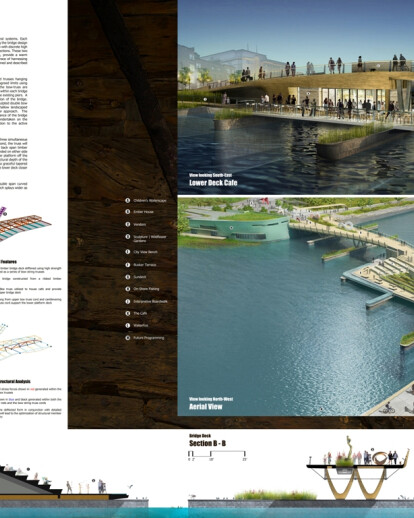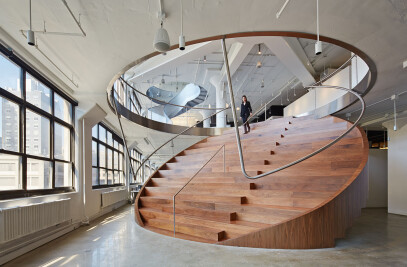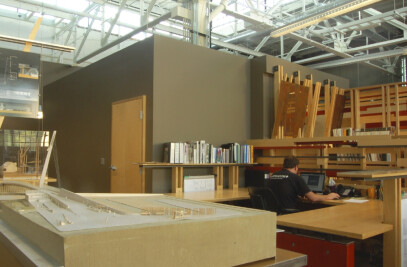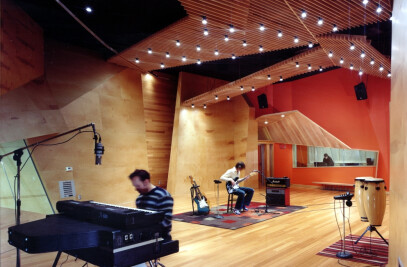A Narrative Description:
The Providence River Pedestrian Bridge is a unique urban proposal in that the basis of its proposition is an exchange of transit medium. The relocation of a substantial, vehicular only conduit in favor of a pedestrian oriented connector will completely transform the spatial character of the Jewelry District/Old Harbor. Given this significant urban transformation, the project should envision a potential much larger than a pure connector. The proposed Providence River Pedestrian Bridge can become a spatial mediator between urban and ecological spaces and function as an integrated series of programs into the waterfront public spaces, allowing east and west to become a singular meandering public space. With this perspective, the proposal is better understood less as a bridge and more as an urban intervention. Additionally, the re-invigorated entrepreneurial spirit of Providence is poised to weather the global economic downturn with a future vision for the emerging Knowledge District and potential new biomedical corridor. The face of this future is one of innovation, intellectual fervor and progressive thinking. A project of this magnitude needs to reach out to this “creative class” and “knowledge economy.”
Orientation:
As a part of the Waterfront Park Master Plan, the Providence River Pedestrian Bridge has a significant responsibility to unify the east and west park spaces into an integrated public environment synthesizing both urban and natural conditions. The alignment of this urban intervention simultaneously considers fluid movement through the city, orientation and views during the procession, and frames of view toward the bridge as an artistic object itself. Circulation of pedestrians and cyclists through the bridge is thought of as a series of tentacles gathering and dispersing travelers from numerous regions and directions. The east side of the bridge splinters into varying directions indicating subtle axis towards James Street, Transit Street, and a continuity of movement along the riverfront walk to both the north and the south. The west side is mediated with the sculpture|wildflower garden that orients travelers in four different directions. Circulation to/from the knowledge district occurs through a newly created urban pedestrian only streetscape along the south side of the amphitheater. The urban street is situated to accommodate a future mixed-use structure to the south and is aligned with Ship Street, denoting an entry into the burgeoning redefined district at the location of the newly constructed Brown Medical Education Building. A second connection is aligned with the Dorrance Street Promenade providing a more contiguous connection from DownCity into the crossing over the river. Two other sinuous connections occur meandering into a walk leading up Peck Street to the Historic Arcade and also leading north along the existing river walk.
Form and Materials:
The morphology of the urban intervention is characterized directly by the program considerations, orientation of access, views (urban and natural), and the amazing dichotomy between the history of Providence and the future of innovation. The uniqueness of the bridge form itself benefits the city more as less of an object over the river and more of an intervention into the landscape of the city with programmatic elements that serve the city in all four seasons. From 17th and 18th century tall ships to late 19th and early 20th century jewelry factories, timber construction characterized much of the celebrated beauty of historical Providence. Timber and wood are still prized today for their old world character and warmth. Wood is an exceptionally versatile material and with modern innovations, timber construction is remarkably efficient and capable of creating formal characteristics reminiscent of historical ships while simultaneously morphing into innovative contemporary solutions. The urban intervention is immersed within a duality of synthesizing traditional materials of granite and timber into programs that can feel both substantial and lacy, and weave an occupiable ground plane into a seamless connection between the east and west.
Programming:
The potential programming of the urban intervention magnifies the connectivity of residential districts, commerce, tourism and culture. Further it opens potential for environmental interpretive nodes educating both residents and visitors about the history and ecology of the Providence, Seekonk and Taunton Rivers, as well as the Narragansett Bay. The success of the City of Providence developing arts, culture and tourism coupled with the vision for the Waterfront Parks; position Providence to become an international cultural destination. The design approach considers the potential of the city momentum created through events that identify the past, present and future culture of the city such as Sound Session, Bright Night Providence, First Works Art Festival, and the integration of WaterFire. The urban intervention manipulates form to create occupiable zones with a significant frequency, thereby maintaining a connected urban space from DownCity and the Knowledge District into the West Waterfront Park and over to the East Waterfront Park. Programmatic considerations are woven directly into the project. The following is a descriptive list of programmatic elements: • Children’s Waterscape- At the nexus of the Dorrance St. Promenade and the bridge transition, a waterscape is situated at the highest activity zone. Among the water features, interactive water jets and ground geysers occur within the concrete splash pad. • Ember House- A revised location and configuration for the Ember House is proposed to create a more contiguous connection between the various axis developed and the bridge approach. • Food & Craft Vendors can fill numerous open spaces within the connected urban streetscape. • The Sculpture|Wildflower Gardens are extended from the West Waterfront Park onto the bridge deck creating an ambiguous relationship between park and bridge. Continuity of seamless program eliminates a condition of threshold as visitors meander over the water. • City View Bench- A specific seating area within the bridge denotes a prime viewing area aligned with the point of the river junction and city skyline to the north. It is the most elevated portion of the bridge deck. • Busker Terrace- A cascading terrace to the south provides an ideal space for seated views to the south, enjoying lunch, and listening to buskers or street performers taking advantage of an informal congregation. • Sundeck- Close to the water with a reflecting pool, the edge of the pool visually connects to the river water below. Southern exposure creates a great environment for taking in summer sun rays. • On-shore fishing can occur along the eastern embankment where newly constructed wetlands provide a great water habitat. • Interpretive Boardwalk is a more slender walkway sitting lower to the water immersed in the constructed wetland habitat. Interpretive signage provides visitors information about the habitat and provides an eastside connection to a potential future Environmental Interpretive Center to the west. • The Café- A café is nestled into the lower deck of the bridge providing simple beverages and potential pastries, etc. with seating locations close to the water and a beautiful view of the skyline to the north and west; ideal for sunsets. • WaterFire is integrated into the pier structures, along the riverfront, and creates an edge for the bridge to the south. Future Programming Although not considered a part of this proposal, the proposed design recommends potential amendments to the current Waterfront Master Plan for conceptual consideration that would include a future Environmental Interpretive Center at the river edge and a future Mixed-Use Facility along the South Edge of the West Waterfront Park. The integration of these structures as public/private partnerships increases the activation of the overall plan in areas of need, and provides future opportunities to the private sector during the period of economic rebound that will eventually be sparked within the Knowledge District.
Structural Narrative:
The proposed urban intervention can be considered as three principle structural systems. Each component holds its own unique challenges and innovative design solution. Unifying the bridge design is the use of Glue Laminated Timber as the primary structural material in conjunction with discrete high strength steel tension rod components utilized on both the east and west bridge sections. These two materials, which are in dichotic contrast to the existing cold concrete structure, provide a warm traditional aesthetic through the timber framing, coupled with the lightness and grace of harnessing the tensile strength of steel. The three structural systems aforementioned are outlined and described below. Eastern Span:
A shallow 12" timber bridge deck frame is stiffened using bow string steel rod trusses hanging approximately 6' below the timber deck. The steel rods will be pre-tensioned to agreed limits using adjustable turnbuckle mechanisms. In-plane compressive forces generated by the bow-truss are resolved within the primary timber deck beams. Resolving the opposing arch forces within each bridge section in this way will ensure that only nominal lateral loads are transferred into the exiting piers. A tapered deck edge with an upturned rail profile help to soften the blunt elevation of the bridge. Support of the bridge deck sections will be taken from the existing piers through sculpted double bow timber compression struts. The timber bridge decks are designed to support shallow landscaped planter boxes recessed into the upper timber frame on the westernmost scissor approach. The dynamics of the slim bridge deck will be analyzed in detail to assess the performance of the bridge under crowd loading conditions. Preassembly of the bridge sections can be undertaken on the adjoining Western shore and rolled, or craned into position minimizing disruption to the active westernmost waterway.
Western Span:
A deep timber box truss is utilized on the eastern portion of the bridge to perform three simultaneous functions. First, it will provide an outer frame to house the cafe space within. Second, the truss will support the upper bridge deck surface. Third, through the incorporation of deep back span timber beams, and in certain areas steel hangers, cantilevering timber members, are suspended on either side of the lower truss to form the lower bridge deck platform. By supporting the lower platform off the deep spine truss instead of spanning the full 65' pier to pier the overall structural depth of the lower platform is significantly reduced. This will allow the lower platform to retain a graceful tapered leading edge in sympathy to the western and northern bridge sections, and bring the lower deck closer to the water surface.
Interpretive Boardwalk A single 36" deep glue laminated timber beam provides the support for the double span curved interpretive boardwalk. Tapered timber ribs add a graceful profile to the bridge, which splays wider as it approaches the eastern river bank landing.

































